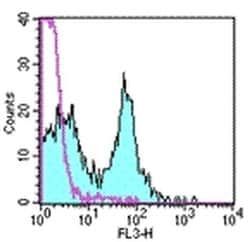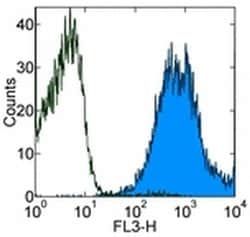50-140-44
CD38 Monoclonal Antibody (90), PE-Cyanine5, eBioscience™, Invitrogen™
Manufacturer: Invitrogen
Select a Size
| Pack Size | SKU | Availability | Price |
|---|---|---|---|
| Each of 1 | 50-140-44-Each-of-1 | In Stock | ₹ 30,883.00 |
50-140-44 - Each of 1
In Stock
Quantity
1
Base Price: ₹ 30,883.00
GST (18%): ₹ 5,558.94
Total Price: ₹ 36,441.94
Antigen
CD38
Classification
Monoclonal
Concentration
0.2 mg/mL
Formulation
PBS with 0.1% gelatin and 0.09% sodium azide; pH 7.2
Gene Accession No.
P56528
Gene Symbols
Cd38
Purification Method
Affinity chromatography
Regulatory Status
RUO
Gene ID (Entrez)
12494
Content And Storage
4° C, store in dark, DO NOT FREEZE!
Form
Liquid
Applications
Flow Cytometry
Clone
90
Conjugate
PE-Cyanine5
Gene
Cd38
Gene Alias
T10, ADP-ribosyl cyclase 1, ADP-ribosyl cyclase/cyclic ADP-ribose hydrolase, CD38 antigen p45, NAD+ nucleosidase, cADPr hydrolase 1, cyclic ADP-ribose hydrolase 2
Host Species
Rat
Quantity
100 μg
Primary or Secondary
Primary
Target Species
Mouse
Product Type
Antibody
Isotype
IgG2a κ
Description
- Description: The 90 monoclonal antibody reacts with the mouse CD38 molecule, an ∽42 kDa type II transmembrane protein
- CD38 is expressed at increasingly higher levels on B cells at each stage of B-cell differentiation, and is then down-regulated on germinal center B cells and mature plasma cells
- Its expression is reported on a subpopulation of thymocytes, mature T cells, and NK cells
- Crosslinking of CD38 on the surface of mature, resting B cells induces B-cell proliferation, which is enhanced by co-signals such as IL-4 and LPS
- CD38, a counter-receptor for CD31, is an ectoenzyme with cyclase and hydrolase enzymatic activity and is speculated to play a role in lymphocyte activation and differentiation
- Applications Reported: The 90 antibody has been reported for use in flow cytometric analysis
- Applications Tested: The 90 antibody has been tested by flow cytometric analysis of mouse splenocytes
- This can be used at less than or equal to 0.06 µg per test
- A test is defined as the amount (µg) of antibody that will stain a cell sample in a final volume of 100 µL
- Cell number should be determined empirically but can range from 10^5 to 10^8 cells/test
- It is recommended that the antibody be carefully titrated for optimal performance in the assay of interest
- Light sensitivity: This tandem dye is sensitive photo-induced oxidation
- Please protect this vial and stained samples from light
- Fixation: Samples can be stored in IC Fixation Buffer (cat
- 00-8222) (100 µL cell sample + 100 µL IC Fixation Buffer) or 1-step Fix/Lyse Solution (cat
- 00-5333) for up to 3 days in the dark at 4°C with minimal impact on brightness and FRET efficiency/compensation
- Some generalizations regarding fluorophore performance after fixation can be made, but clone specific performance should be determined empirically
- Excitation: 488-561 nm; Emission: 667 nm; Laser: Blue Laser, Green Laser, Yellow-Green Laser
- Filtration: 0.2 μm post-manufacturing filtered
- CD38 (NAD+ glycohydrolase) is a type II transmembrane glycoprotein able to induce activation, proliferation and differentiation of mature lymphocytes and mediate apoptosis of myeloid and lymphoid progenitor cells
- CD38 functions as a multi-catalytic ectoenzyme serving as ADP-ribosyl cyclase, cyclic ADP-ribose hydrolase and possibly NAD+ glycohydrolase or as a cell surface receptor
- Antibodies to CD38 are useful in subtyping of lymphomas and leukemias, detection of plasma cells (i.e
- identification of myelomas), and as a marker for activated B and T cells
- CD38 participates in cell adhesion, signal transduction and calcium signaling
- Further, CD38 is expressed at high levels in the pancreas, liver, kidney, maligt lymphoma and neuroblastoma
- Diseases associated with CD38 dysfunction include chronic lymphocytic leukemia and Richter’s Syndrome.
Compare Similar Items
Show Difference
Antigen: CD38
Classification: Monoclonal
Concentration: 0.2 mg/mL
Formulation: PBS with 0.1% gelatin and 0.09% sodium azide; pH 7.2
Gene Accession No.: P56528
Gene Symbols: Cd38
Purification Method: Affinity chromatography
Regulatory Status: RUO
Gene ID (Entrez): 12494
Content And Storage: 4° C, store in dark, DO NOT FREEZE!
Form: Liquid
Applications: Flow Cytometry
Clone: 90
Conjugate: PE-Cyanine5
Gene: Cd38
Gene Alias: T10, ADP-ribosyl cyclase 1, ADP-ribosyl cyclase/cyclic ADP-ribose hydrolase, CD38 antigen p45, NAD+ nucleosidase, cADPr hydrolase 1, cyclic ADP-ribose hydrolase 2
Host Species: Rat
Quantity: 100 μg
Primary or Secondary: Primary
Target Species: Mouse
Product Type: Antibody
Isotype: IgG2a κ
Antigen:
CD38
Classification:
Monoclonal
Concentration:
0.2 mg/mL
Formulation:
PBS with 0.1% gelatin and 0.09% sodium azide; pH 7.2
Gene Accession No.:
P56528
Gene Symbols:
Cd38
Purification Method:
Affinity chromatography
Regulatory Status:
RUO
Gene ID (Entrez):
12494
Content And Storage:
4° C, store in dark, DO NOT FREEZE!
Form:
Liquid
Applications:
Flow Cytometry
Clone:
90
Conjugate:
PE-Cyanine5
Gene:
Cd38
Gene Alias:
T10, ADP-ribosyl cyclase 1, ADP-ribosyl cyclase/cyclic ADP-ribose hydrolase, CD38 antigen p45, NAD+ nucleosidase, cADPr hydrolase 1, cyclic ADP-ribose hydrolase 2
Host Species:
Rat
Quantity:
100 μg
Primary or Secondary:
Primary
Target Species:
Mouse
Product Type:
Antibody
Isotype:
IgG2a κ
Antigen: CD38
Classification: Monoclonal
Concentration: 5 μL/Test
Formulation: PBS with 0.2% BSA and 0.09% sodium azide; pH 7.2
Gene Accession No.: P28907
Gene Symbols: CD38
Purification Method: Affinity chromatography
Regulatory Status: RUO
Gene ID (Entrez): 952
Content And Storage: 4° C, store in dark, DO NOT FREEZE!
Form: Liquid
Applications: Flow Cytometry
Clone: HIT2
Conjugate: PE-Cyanine5
Gene: CD38
Gene Alias: 2'-phospho-ADP-ribosyl cyclase; 2'-phospho-ADP-ribosyl cyclase/2'-phospho-cyclic-ADP-ribose transferase; 2'-phospho-cyclic-ADP-ribose transferase; ADPRC 1; ADPRC1; ADP-ribosyl cyclase 1; ADP-ribosyl cyclase/cyclic ADP-ribose hydrolase 1; cADPr hydrolase 1; Cd38; CD38 antigen; CD38 antigen (ADP-ribosyl cyclase / cyclic ADP-ribose hydrolase); CD38 antigen (p45); CD38 antigen p45; CD38 molecule; CD38H; Cd38-rs1; cluster of differentiation 38; cyclic ADP-ribose hydrolase 1; ecto-nicotinamide adenine dinucleotide glycohydrolase; I-19; NAD(+) nucleosidase; NAD+ nucleosidase; NIM-R5 antigen; T10
Host Species: Mouse
Quantity: 100 Tests
Primary or Secondary: Primary
Target Species: Human
Product Type: Antibody
Isotype: IgG1 κ
Antigen:
CD38
Classification:
Monoclonal
Concentration:
5 μL/Test
Formulation:
PBS with 0.2% BSA and 0.09% sodium azide; pH 7.2
Gene Accession No.:
P28907
Gene Symbols:
CD38
Purification Method:
Affinity chromatography
Regulatory Status:
RUO
Gene ID (Entrez):
952
Content And Storage:
4° C, store in dark, DO NOT FREEZE!
Form:
Liquid
Applications:
Flow Cytometry
Clone:
HIT2
Conjugate:
PE-Cyanine5
Gene:
CD38
Gene Alias:
2'-phospho-ADP-ribosyl cyclase; 2'-phospho-ADP-ribosyl cyclase/2'-phospho-cyclic-ADP-ribose transferase; 2'-phospho-cyclic-ADP-ribose transferase; ADPRC 1; ADPRC1; ADP-ribosyl cyclase 1; ADP-ribosyl cyclase/cyclic ADP-ribose hydrolase 1; cADPr hydrolase 1; Cd38; CD38 antigen; CD38 antigen (ADP-ribosyl cyclase / cyclic ADP-ribose hydrolase); CD38 antigen (p45); CD38 antigen p45; CD38 molecule; CD38H; Cd38-rs1; cluster of differentiation 38; cyclic ADP-ribose hydrolase 1; ecto-nicotinamide adenine dinucleotide glycohydrolase; I-19; NAD(+) nucleosidase; NAD+ nucleosidase; NIM-R5 antigen; T10
Host Species:
Mouse
Quantity:
100 Tests
Primary or Secondary:
Primary
Target Species:
Human
Product Type:
Antibody
Isotype:
IgG1 κ
Antigen: CD40
Classification: Monoclonal
Concentration: 0.2 mg/mL
Formulation: PBS with 0.09% sodium azide; pH 7.2
Gene Accession No.: P27512
Gene Symbols: CD40
Purification Method: Affinity chromatography
Regulatory Status: RUO
Gene ID (Entrez): 21939
Content And Storage: 4° C, store in dark, DO NOT FREEZE!
Form: Liquid
Applications: Flow Cytometry
Clone: 1C10
Conjugate: PE-Cyanine5
Gene: CD40
Gene Alias: AI326936; B cell surface antigen CD40; B cell-associated molecule; B-cell surface antigen CD40; Bp50; CD antigen CD40; Cd40; CD40 antigen; CD40 antigen (TNF receptor superfamily member 5); CD40 antigen, TNF receptor superfamily member 5; CD40 molecule; CD40 molecule, TNF receptor superfamily member 5; CD40L receptor; CDw40; GP39; HIGM1; I79_006806; IGM; IMD3; Immunoglobulin M; ImmunoglobulinM; membrane protein CD40; MGC9013; p50; receptor for ligand CD154; sCD40; soluble CD40; T-BAM; T-cell differentiation antigen; Tnfrsf5; TRAP; tumor necrosis factor receptor superfamily member 5; tumor necrosis factor receptor superfamily, member 5
Host Species: Rat
Quantity: 100 μg
Primary or Secondary: Primary
Target Species: Mouse
Product Type: Antibody
Isotype: IgG2a κ
Antigen:
CD40
Classification:
Monoclonal
Concentration:
0.2 mg/mL
Formulation:
PBS with 0.09% sodium azide; pH 7.2
Gene Accession No.:
P27512
Gene Symbols:
CD40
Purification Method:
Affinity chromatography
Regulatory Status:
RUO
Gene ID (Entrez):
21939
Content And Storage:
4° C, store in dark, DO NOT FREEZE!
Form:
Liquid
Applications:
Flow Cytometry
Clone:
1C10
Conjugate:
PE-Cyanine5
Gene:
CD40
Gene Alias:
AI326936; B cell surface antigen CD40; B cell-associated molecule; B-cell surface antigen CD40; Bp50; CD antigen CD40; Cd40; CD40 antigen; CD40 antigen (TNF receptor superfamily member 5); CD40 antigen, TNF receptor superfamily member 5; CD40 molecule; CD40 molecule, TNF receptor superfamily member 5; CD40L receptor; CDw40; GP39; HIGM1; I79_006806; IGM; IMD3; Immunoglobulin M; ImmunoglobulinM; membrane protein CD40; MGC9013; p50; receptor for ligand CD154; sCD40; soluble CD40; T-BAM; T-cell differentiation antigen; Tnfrsf5; TRAP; tumor necrosis factor receptor superfamily member 5; tumor necrosis factor receptor superfamily, member 5
Host Species:
Rat
Quantity:
100 μg
Primary or Secondary:
Primary
Target Species:
Mouse
Product Type:
Antibody
Isotype:
IgG2a κ
Antigen: CD44
Classification: Monoclonal
Concentration: 0.2 mg/mL
Formulation: PBS with 0.09% sodium azide; pH 7.2
Gene Accession No.: P15379, P16070
Gene Symbols: CD44
Purification Method: Affinity chromatography
Regulatory Status: RUO
Gene ID (Entrez): 12505, 960
Content And Storage: 4° C, store in dark, DO NOT FREEZE!
Form: Liquid
Applications: Flow Cytometry
Clone: IM7
Conjugate: PE-Cyanine5
Gene: CD44
Gene Alias: AU023126; AW121933; AW146109; Bovine CD44; CD44; CD44 antigen; CD44 antigen-like protein; CD44 molecule; CD44 molecule (Indian blood group); CD44 protein; CD44 variant; CD44A; CD44-like protein; CDW44; cell surface glycoprotein CD44; Cell surface glycoprotein CD44 (hyaluronate binding protein); cell-surface glycoprotein; chondroitin sulfate proteoglycan 8; CSPG8; ECMRIII; ECMR-III; Epican; extracellular matrix receptor III; extracellular matrix receptor-III; GP90 lymphocyte homing/adhesion receptor; HCELL; hematopoietic cell E- and L-selectin ligand; heparan sulfate proteoglycan; HERMES; Hermes antigen; homing function and Indian blood group system; HUTCH-I; hyaluronan receptor; Hyaluronate receptor; IN; LHR; Ly-24; lymphocyte antigen 24; lymphocyte surface antigen precursor CD44; MC56; MDU2; MDU3; METAA; MIC4; PGP I; Pgp1; PGP-1; PGPI; PGP-I; Phagocytic glycoprotein 1; phagocytic glycoprotein I; putative Bos taurus CD44; RHAMM; sCD 44; sCD44; soluble CD 44; soluble CD44
Host Species: Rat
Quantity: 50 μg
Primary or Secondary: Primary
Target Species: Human, Mouse
Product Type: Antibody
Isotype: IgG2b κ
Antigen:
CD44
Classification:
Monoclonal
Concentration:
0.2 mg/mL
Formulation:
PBS with 0.09% sodium azide; pH 7.2
Gene Accession No.:
P15379, P16070
Gene Symbols:
CD44
Purification Method:
Affinity chromatography
Regulatory Status:
RUO
Gene ID (Entrez):
12505, 960
Content And Storage:
4° C, store in dark, DO NOT FREEZE!
Form:
Liquid
Applications:
Flow Cytometry
Clone:
IM7
Conjugate:
PE-Cyanine5
Gene:
CD44
Gene Alias:
AU023126; AW121933; AW146109; Bovine CD44; CD44; CD44 antigen; CD44 antigen-like protein; CD44 molecule; CD44 molecule (Indian blood group); CD44 protein; CD44 variant; CD44A; CD44-like protein; CDW44; cell surface glycoprotein CD44; Cell surface glycoprotein CD44 (hyaluronate binding protein); cell-surface glycoprotein; chondroitin sulfate proteoglycan 8; CSPG8; ECMRIII; ECMR-III; Epican; extracellular matrix receptor III; extracellular matrix receptor-III; GP90 lymphocyte homing/adhesion receptor; HCELL; hematopoietic cell E- and L-selectin ligand; heparan sulfate proteoglycan; HERMES; Hermes antigen; homing function and Indian blood group system; HUTCH-I; hyaluronan receptor; Hyaluronate receptor; IN; LHR; Ly-24; lymphocyte antigen 24; lymphocyte surface antigen precursor CD44; MC56; MDU2; MDU3; METAA; MIC4; PGP I; Pgp1; PGP-1; PGPI; PGP-I; Phagocytic glycoprotein 1; phagocytic glycoprotein I; putative Bos taurus CD44; RHAMM; sCD 44; sCD44; soluble CD 44; soluble CD44
Host Species:
Rat
Quantity:
50 μg
Primary or Secondary:
Primary
Target Species:
Human, Mouse
Product Type:
Antibody
Isotype:
IgG2b κ



